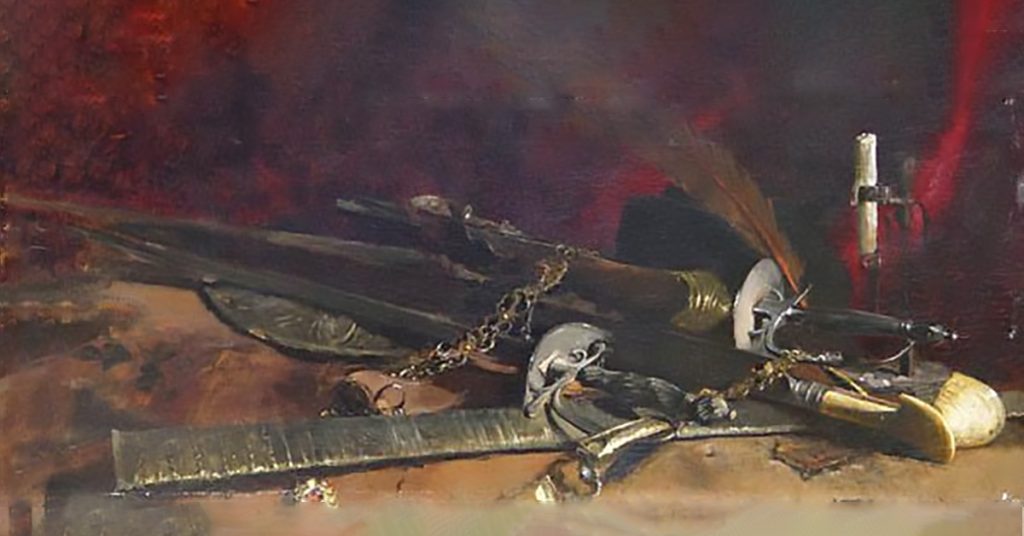Back to Melee Weapon Search
Sword, talwar
Sword, Blade, Sidearm, Cavalry, Central Asia, South Asia, Saber
In India one finds a unique type of saber which is very similar to the Persian shamshir, called a 'tulwar' or ‘talwar’, a saber with a similarly pronounced curve, but a broader blade than a shamshir and usually featuring less acute of a point. Tulwars have a small, tight handle, the grip itself is strait rather than canted like some other sabers, and typically consisting of minimal quillions with a roundel pommel which makes for a very snug grip. The tulwar also often has a sharpened false-edge.
Like all sabers, these are specialized slashing weapons originally designed for use from horseback. Historically these elegant swords were used by Persian, Hindu, Sikh, and Mughal cavalry, starting in the 16th Century. The tulwar in particular was popular with the Sikhs, though eclipsed by the Khanda and the Kirpan (see Jambayia) in Religious importance, the tulwar is the weapon of Rajput cavalry and is the basis of the martial sport Gatka which is still practiced today by Sikhs all around the world.
 Talwar with very long, thin blade. 19th Century, this is a 3/5/3 weapon with Primary Attack Types SP
Talwar with very long, thin blade. 19th Century, this is a 3/5/3 weapon with Primary Attack Types SP  Talwar with a broad, short blade and an engraved gold ‘ferengi’ style hilt, 18th Century. This weapon is Primary Attack Type SC.
Talwar with a broad, short blade and an engraved gold ‘ferengi’ style hilt, 18th Century. This weapon is Primary Attack Type SC.  Talwar with a silver plated and gilded hilt, and a reinforced point, 18th Century. This weapon is Primary Attack Types SP, with +1 AP for Piercing attacks.
Talwar with a silver plated and gilded hilt, and a reinforced point, 18th Century. This weapon is Primary Attack Types SP, with +1 AP for Piercing attacks.  A Lahore Talwar with engraved, gold ‘ferrengi’ style hilt, and long wootz steel blade. This is a 3/5/3 weapon, with Primary Attack Types SP, D10 damage, Hardness 12.
A Lahore Talwar with engraved, gold ‘ferrengi’ style hilt, and long wootz steel blade. This is a 3/5/3 weapon, with Primary Attack Types SP, D10 damage, Hardness 12.
| Name | Size | Reach | Speed | Defense | Base Damage | Attack Types | Primary Attack Types | Armor Pierce | Grapple | Hardness | HP |
|---|---|---|---|---|---|---|---|---|---|---|---|
| Sword, talwar | M | 2 | 5 | 3 | 1-8 | SCP | S | 0 | 0 | 10 | 3 |
 Talwar with very long, thin blade. 19th Century, this is a 3/5/3 weapon with Primary Attack Types SP
Talwar with very long, thin blade. 19th Century, this is a 3/5/3 weapon with Primary Attack Types SP  Talwar with a broad, short blade and an engraved gold ‘ferengi’ style hilt, 18th Century. This weapon is Primary Attack Type SC.
Talwar with a broad, short blade and an engraved gold ‘ferengi’ style hilt, 18th Century. This weapon is Primary Attack Type SC.  Talwar with a silver plated and gilded hilt, and a reinforced point, 18th Century. This weapon is Primary Attack Types SP, with +1 AP for Piercing attacks.
Talwar with a silver plated and gilded hilt, and a reinforced point, 18th Century. This weapon is Primary Attack Types SP, with +1 AP for Piercing attacks.  A Lahore Talwar with engraved, gold ‘ferrengi’ style hilt, and long wootz steel blade. This is a 3/5/3 weapon, with Primary Attack Types SP, D10 damage, Hardness 12.
A Lahore Talwar with engraved, gold ‘ferrengi’ style hilt, and long wootz steel blade. This is a 3/5/3 weapon, with Primary Attack Types SP, D10 damage, Hardness 12.
